 Back around 1984, this Rossi Model 92 in 357 Magnum was my hog rifle. Using the Lee 358-140-SWC cast bullet @ 1400 fps, I killed many wild and open range hogs with this rifle. While replacing the sights with sights I could see after the passing of 20+ years, I decided to work up a different cast bullet load. I knew several things about the load before I started:
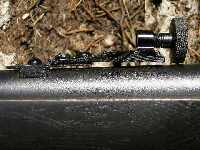
New rear peep sight |
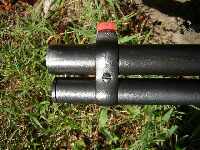
New front sight |
- The load would be a max 50 to 75 yard hog, deer, and beer can load.
- Although the Lee 358-140-SWC bullet @ 1400 fps killed hogs just fine, I wanted a bullet with a little more weight and a little more velocity.
- I wanted a Lee Tumble Lube design in a 6-cavity mold. Two coats of Lee Liquid Alox on the bullets. No sizing. No gas checks. Just cast a pile of bullets fast and lube 'em even faster.
- For alloy, my stash of plain ol' wheelweight ingots. No fancy mixes. No water quenching the resulting bullets. Just visual sorting, no weighing.
- I wanted a muzzle velocity just below the velocity which leaded the barrel. From experience with my alloy and non-gas checked bullets and Lee Liquid Alox in other rifles, I expected the leaded-barrel velocity to be ~1600 fps.
- Over the Chrony, the load's Extreme Spread (ES) high velocity figure must be such that no individual bullet would reach the leaded-barrel velocity. I planned to clean the bore only in the event of it falling in a creek.
- The load's accuracy must be such that from 50 yards with the rifle's peep sights and from a cold barrel and in dim light, 5 of 5 shots hit the 5 1/2" bullseye of an NRA
B-8C(P) target.
- Whatever charge of whatever powder gave me all of the above, would be thrown by a cavity in one of the four disks in a Lee Auto-Disk Powder Measure. Every step in the process of producing this hog/deer/beer can load would be designed for ease and speed. That included using Lee's trick combination of powder-through-expander die and Auto-Disk Powder Measure. With the 357 Magnum's approximate usable case capacity of 1.16 cc, the cavities I assumed I would test were: .88 cc, .95 cc, 1.02 cc, 1.09 cc, 1.18 cc, and maybe 1.26 cc.
- I would begin with 2400 powder because that's what I had on hand.
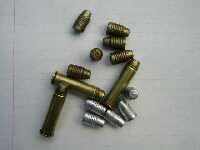 I picked the Lee TL-358-158-SWC mold. From my alloy, the bullets averaged 155.9 grs in weight, naked. My micrometer measured them at a uniform .358" in diameter and .645" in length. Seated to the bottom of the crimping groove, as you see them here, and heavily crimped with a Lee Carbide Factory Crimp Die, the Cartridge OverAll Length (C.O.A.L) measured 1.570".
I picked the Lee TL-358-158-SWC mold. From my alloy, the bullets averaged 155.9 grs in weight, naked. My micrometer measured them at a uniform .358" in diameter and .645" in length. Seated to the bottom of the crimping groove, as you see them here, and heavily crimped with a Lee Carbide Factory Crimp Die, the Cartridge OverAll Length (C.O.A.L) measured 1.570".
I lubed the bullets once with Lee Liquid Alox, let them dry, then lubed them again. Notice the heavy coat of lube on the nose of the bullet standing in the center. To avoid gumming up the seater and the resulting variation in seating depths, I wiped the noses of all bullets before seating. I left the heavy coat of lube on the ogive of the bullets. It won't rub off in the magazine tube, so why not leave it there for extra lube during the critical start up phase?
 Here's 3 of several 75 yard, 3-shot groups shot while adjusting/filing down the new front sight. These groups showed me 2 things: Here's 3 of several 75 yard, 3-shot groups shot while adjusting/filing down the new front sight. These groups showed me 2 things:
- The rifle and load would easily meet my objective of putting 5 shots in a 5 1/2" bullseye in dim light at 50 yards.
- I loaded these and other sight adjusting/testing rounds using Lee Dippers for muzzle velocities of 1500 to 1600 fps. Any round exceeding 1600 fps leaded the barrel.
The sights adjusted on-bullseye @ 25 yards, I began shooting 14-shot groups over the Chrony. I loaded 15 rounds, shooting them in sequences of 5 shots. As the first shot of the first sequence was a fouling shot aimed away from the Chrony and the target, the groups contain 14 shots for record. After each 5 shot sequence, I cooled the barrel via compressed air through the bore. Here's the load components:
- Bullets: Lee TL-358-158-SWC in wheelweight alloy. Average weight naked 155.9 grs. Twice lubed with Lee Liquid Alox.
- Brass: Used Winchester, trimmed, chamfered.
- Primers: CCI 500.
- Powder: 2400 & IMR4227.
- C.O.A.L 1.570".
NOTE: The following loads are safe in my rifle only and with my components only. Some are maximum loads in some manuals. Do not use in a pistol. Do not use mag primers.
If you can't follow directions, click here.
 I began with .95 cc of 2400 (11.9 grs). The photo shows the results—a decent group but with high and low fliers, low Average Velocity, and very poor Extreme Spread. I began with .95 cc of 2400 (11.9 grs). The photo shows the results—a decent group but with high and low fliers, low Average Velocity, and very poor Extreme Spread.
- AV = 1454 fps
- ES = 138 fps
Switching to the 1.02 cc cavity (12.8 grs 2400) gave only slightly better results.
- AV = 1526 fps
- ES = 98 fps
- High V = 1578 fps
Obviously, another increase in the 2400 charge would give further improvement to the high ES figure. However, I didn't feel safe with an increase. (1) Pressure was rising, and, (2) the load's high velocity figure was only 22 fps below the barrel-leading point of 1600 fps. Time to try a different powder. I wanted H4227 as a first choice and H110 as a second choice. The dealer only carried IMR4227, so that's what I used.
I began by charging single rounds with IMR4227 using different Auto-Disk cavities and shooting those rounds over the Chrony. I wanted a velocity around 1550 fps. If I found a cavity which threw a charge of IMR4227 which gave me that approximate velocity with acceptable pressure, I would then shoot a 14 round group for record. The cavity/charge/velocity results:
- 1.02 cc cavity = 13.0 gr IMR4227 = 1335 fps
- 1.18 cc cavity = 14.8 gr IMR4227 = 1415 fps
- 1.26 cc cavity = 16.3 gr IMR4227 = 1569 fps
So, one somewhat compressed load of IMR4227 from the 1.26 cc cavity gave me my desired velocity. What about pressure? The load using a 158 gr jacketed bullet was max in the IMR Powder online manual and listed a velocity of 1605 fps. But my cast bullet 1569 fps case head and primer looked exactly the same and recoiled about the same as the cast bullet 1335 fps case head and primer. One at a time, I then loaded three more rounds with the 1.26 cc cavity and fired the rounds into my 25 yard range's backing plate. All looked and felt well, so I loaded 15 rounds for record.
And I discovered a problem. Some of the loaded rounds were longer that their brethren. Close inspection showed some of the bullets protruding farther from the case than others. After a few minutes of head scratching, I discovered why. I had seated the bullets with a regular seating die set for zero crimp. In a separate step, I had provided a heavy crimp with a Lee Carbide Factory Crimp Die. While awaiting their trip through the Lee Carbide Factory Crimp Die, the compressed powder charges had pushed the bullets up slightly in the non-crimped cases. So, now, they were crimped in varying locations on the bullets as the Lee Carbide Factory Crimp Die only crimped them, not seated them. I had to readjust the regular seating die for a slight crimp and run all 15 rounds through it again, reseating all 15 bullets and mangling the grooves of several of them. But, heck, they didn't look real bad, and, besides, it was getting dark outside by then, so I decided to shoot them anyway.
 The photo shows the results. One called high flier and one low flier probably due to mangled grooves. But in the center there's a nice round group of 12 shots in 2 1/4" x 1 7/8" @ 25 yards in dim light. And zero lead in the barrel. And good Chrony results: The photo shows the results. One called high flier and one low flier probably due to mangled grooves. But in the center there's a nice round group of 12 shots in 2 1/4" x 1 7/8" @ 25 yards in dim light. And zero lead in the barrel. And good Chrony results:
- AV = 1549 fps
- ES = 51 fps
- SD = 16 fps
- High V = 1575 fps
The 1575 fps High V figure was safely below the 1600 fps barrel-leading point, especially with a low ES of only 51 fps. Looked like I had my hog/deer/beer can load. Only thing left was to see how it did @ 50 yards on the 5 1/2" bullseye in dim light.
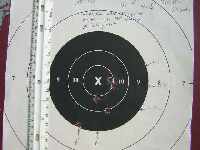 Late the next evening I loaded 5 rounds with good crimps, then I hung a B-8C(P) target @ exactly 50 yards and in a deeply shaded section of my shooting range. I then waited for the sun to go down. Only the addition of rain would have made a better simulation of actual hunting conditions. Just before it was too dark to shoot, and placing the bullseye on top of the front sight as I did with the 25 yard groups and starting with a cold barrel, I fired the group. Late the next evening I loaded 5 rounds with good crimps, then I hung a B-8C(P) target @ exactly 50 yards and in a deeply shaded section of my shooting range. I then waited for the sun to go down. Only the addition of rain would have made a better simulation of actual hunting conditions. Just before it was too dark to shoot, and placing the bullseye on top of the front sight as I did with the 25 yard groups and starting with a cold barrel, I fired the group.
For shots #1, #2, and #3, I used a .050" target aperture. For #4 and #5 and for further simulation of actual hunting conditions, I used a .150" hunting aperture. The results speak for themselves—all 5 shots in the bullseye. Notice the center of the group in the center of a beer can if placed on top of the front sight blade.
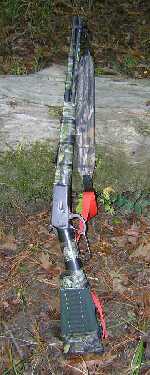 Come February or March of next year and Hog Camp 2005, my Rossi Model 92 357 Magnum will haunt the hog woods again. With plenty of power for 75 yard shots and with 10 rounds in the magazine, 1 in the chamber, and 9 in a buttstock carrier—20 rounds total—it's the ideal deep woods hog rifle.
Come February or March of next year and Hog Camp 2005, my Rossi Model 92 357 Magnum will haunt the hog woods again. With plenty of power for 75 yard shots and with 10 rounds in the magazine, 1 in the chamber, and 9 in a buttstock carrier—20 rounds total—it's the ideal deep woods hog rifle.
Here we see the Rossi tricked out for the deer & hog woods. That's camo duct tape. This photo was actually taken in deep woods on a hunt. While taking a snack break on the log, I thought it looked photogenic. When deer season ends, I will replace the hunter orange sling strap with an olive drab strap.
Thanks Richard Lee!!!
|








